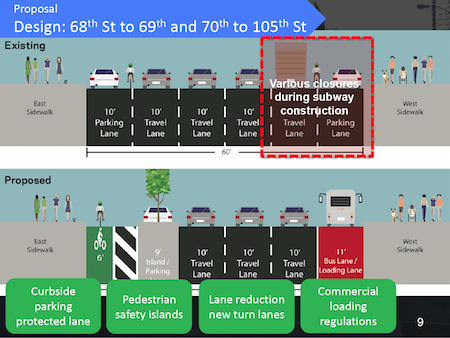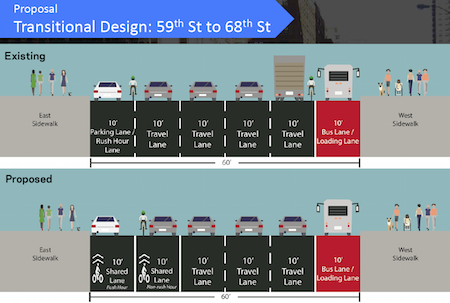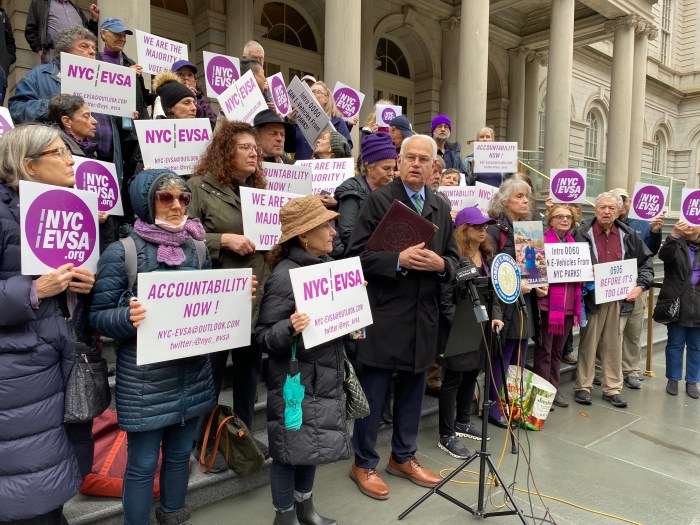
BY JACKSON CHEN | The city’s Department of Transportation (DOT) announced a significant southbound connection between two existing East Side bike lanes during a Community Board 8 meeting on January 6.
According to the plans, the DOT will install a bike lane on the section of Second Avenue that runs south from East 105th Street to East 59th Street as part of Mayor Bill de Blasio’s Vision Zero initiative. The mayor’s plan to end traffic fatalities identified this stretch of Second Avenue and the intersection of Second and East 79th Street, in particular, as points ripe for safety improvements.
Along this Second Avenue corridor, the DOT found there was an increase in bikers during 12-hour timeframes between October 2011 and October 2015 from 631 to 940.
The DOT proposes to create a shared bike lane from East 68th Street to East 59th Street, which will connect to the existing shared bike lane south of 59th Street. From East 105th Street to East 68th Street, the agency will install a protected bike lane that will connect to the similarly protected bike lane north of 105th Street.
The road configuration from East 105h Street to East 68th Street is currently set up as two parking lanes and four travel lanes. Recently, the Second Avenue Subway efforts have oftentimes left two lanes closed off for construction.
Coinciding with the end of construction, the DOT will be converting the lane closest to the west sidewalk into a weekday-only Select Bus Service and loading lane and installing a six-foot protected bike lane with a buffer on the eastern-most lane. Motorists will be losing one travel lane that will be replaced with pedestrian islands, left-turn bays, and some parking space.
According to the DOT plans, there will be a slight shift from East 69th Street to East 70th Street due to a sidewalk extension that makes room for a new Second Avenue Subway station. While the protected bike lane continues, there will be no parking on this block, according to the plans.
As for the shared lane design from 68th Street to 59th Street, DOT will be converting a parking lane, which becomes a travel lane during rush hours, into a shared lane of bikes and cars during rush hours. During off hours, when parking is allowed in the eastern-most lane, cyclists will still be sharing a travel lane with vehicles in the next lane over.
While the Community Board 8’s Transportation Committee was happy to see more safety protocols, its members expressed concern for the nine blocks that would not have protection.

“It was hoped by me and several other people that there would be less of a gap in the protected lanes, if any, in the Second Avenue presentation,” said Scott Falk, co-chair of the community board’s Transportation Committee.
Committee members argued that some of the district’s most dangerous intersections fall within the area between East 68th Street and East 59th Street, where there will only be shared bike lanes.
DOT officials responded that due to the proximity to the Queensboro Bridge’s Second Avenue entrance, they had to create shared lanes to maintain travel lanes and not exacerbate congestion issues.
“I understand that immediately at the bridge is going to require a tremendous amount of thought and creativity,” Falk said, but added, “To have shared lanes for so many lanes leading up to [the bridge] is a real serious concern.”
Among residents who spoke up, some suggested more patience and planning were needed before a plan was adopted. Jill Eisner, a longtime Upper East Sider, said the DOT should wait until the Second Avenue Subway construction is completed and then figure out how the traffic flows.
“Why don’t they pave it over, let us enjoy traffic moving smoothly, and see what’s going to happen,” Eisner said of the expected end of construction. “Then after those traffic patterns have been ascertained, then decide what to do.”
Those who praised the bike lane plans said they would create more order and safety on Second Avenue. Paul Krikler, a resident who bikes 10 to 11 months out of the year, said there would be fewer reckless cyclists — like those who go the wrong way on the northbound First Avenue bike lanes — because of the availability of the appropriate bike lanes.
Krikler, who currently uses Second Avenue as a southbound route, said the trip down is very precarious, especially with the subway workers in some of the lanes. With the new bike lanes, the resident is expecting every stakeholder to benefit.
“Why wouldn’t a motorist be more comfortable knowing they won’t be hitting a cyclist,” Krikler said. “It’s a win for everybody.
After hearing many community comments, the DOT is expecting to begin implementation in summer 2016, but that the start date hinges on the agency’s coordination with the MTA and its Second Avenue Subway construction.






































